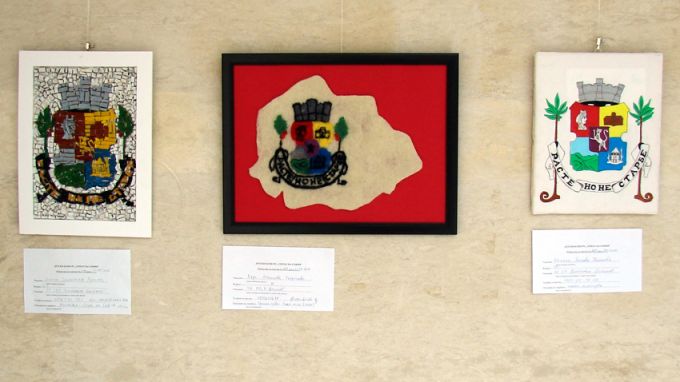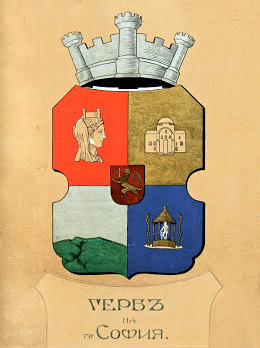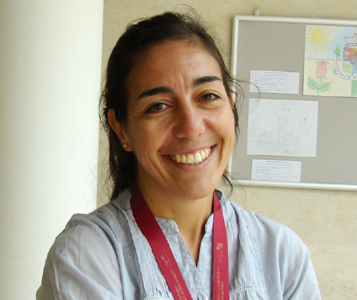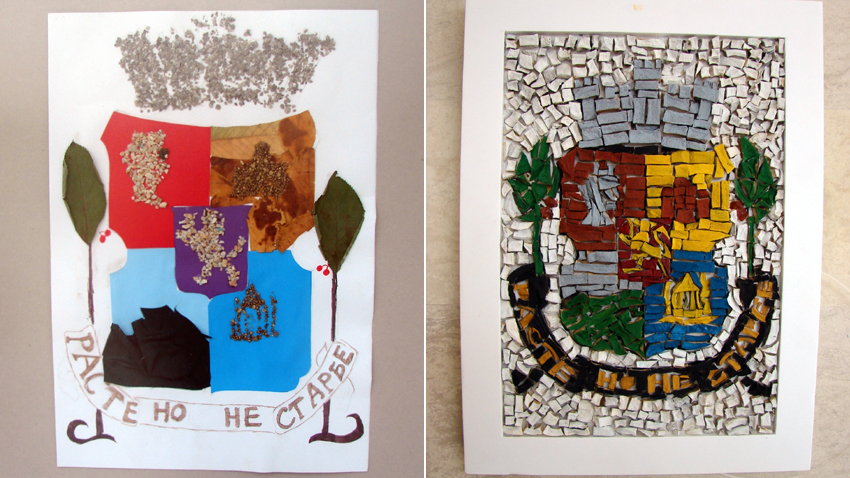 3
3
Several days before the Day of Sofia (marked on September 17) the Sofia History Museum presented works of the participants at the Sofia Coat of Arms contest. Children aged between seven and fourteen from Bulgaria's capital and the surrounding region joined the competition. They had the difficult task to describe Sofia's coat of arms their own way. Let us remind how Bulgarian painter Haralampi Tachev created Sofia's coat of arms in the remote 1900.
 He had to create Sofia's coat of arms for the Paris Exposition Universelle. Initially a crown of walls and towers was placed above a shield which was divided into four sections. Ulpia Serdica was depicted on the upper left quarter and the Saint Sofia Church took up the upper right quarter. Vitosha Mountain and the Statue of Apollo Medicus symbolizing the antique healing mineral springs in Sofia were placed in the lowest quarters of the coat of arms. In the middle is another shield with a lion rampant. The image of the lion was copied from a medallion found near the town of Veliko Tarnovo. The lion symbolizes the succession between the two Bulgarian capitals Sofia and Veliko Tarnovo. In 1911 the motto: Ever Growing, Never Ageing was added to Sofia's coat of arms at the proposal of Deputy Mayor Radi Radev.
He had to create Sofia's coat of arms for the Paris Exposition Universelle. Initially a crown of walls and towers was placed above a shield which was divided into four sections. Ulpia Serdica was depicted on the upper left quarter and the Saint Sofia Church took up the upper right quarter. Vitosha Mountain and the Statue of Apollo Medicus symbolizing the antique healing mineral springs in Sofia were placed in the lowest quarters of the coat of arms. In the middle is another shield with a lion rampant. The image of the lion was copied from a medallion found near the town of Veliko Tarnovo. The lion symbolizes the succession between the two Bulgarian capitals Sofia and Veliko Tarnovo. In 1911 the motto: Ever Growing, Never Ageing was added to Sofia's coat of arms at the proposal of Deputy Mayor Radi Radev.
One hundred and sixteen years later the Sofia Museum of History shows how Sofia's coat of arms evolved in the imagination of its youngest citizens. Erina Krasteva who works at that museum told Radio Bulgaria details about the competition.
 “We organized Sofia's Coat of Arms contest at the proposal of our curator Dr Nadezhda Kirova Yovcheva. We received many works such as paintings, art installations, models and mosaics made of non-traditional material. We are very happy with the fact the children let their imagination run free. The festive week started with an exhibition of their works. Stoyan Dechev held a lecture about Sofia's coat of arms and how it evolved through the years. A jury formed by members of the Sofia Museum of History already judged those works of art. The winners will be announced at an official ceremony on September 17 when we mark the Day of Sofia.”
“We organized Sofia's Coat of Arms contest at the proposal of our curator Dr Nadezhda Kirova Yovcheva. We received many works such as paintings, art installations, models and mosaics made of non-traditional material. We are very happy with the fact the children let their imagination run free. The festive week started with an exhibition of their works. Stoyan Dechev held a lecture about Sofia's coat of arms and how it evolved through the years. A jury formed by members of the Sofia Museum of History already judged those works of art. The winners will be announced at an official ceremony on September 17 when we mark the Day of Sofia.”
The contest does not restrict children to use certain materials only. Every child imagines the coat of arms its own way. That is why their works were filled with extraordinary power. What are the most interesting works at this year's contest? More from curator Nadezhda Yovcheva:
“We displayed an art installation made of seeds. The tesserae of one of the mosaics were made of dried mushrooms dyed in the colors of Sofia's coat of arms. Of course children used paint the most. However, they presented alternative symbols of that city. In 1900 Sofia had its emblems, but nowadays other buildings and landmarks are symbolizing the city.”

The children spent part of their precious time during of their summer vacation to express themselves. Moreover, all participants would like to receive prizes for their works.
“The participants will receive interesting prizes. The winner will receive a plaque and luxurious art supplies. Those who place second and third will receive diplomas and something every future artist would like to possess. Besides, the jury will present a special prize to one of the participants as well.”
The name of the child who will receive the special prize will be kept in secrecy until the final on September 17. Until then visitors can see all works at the Sofia Museum of History. They are displayed in a separate exhibition hall and the organizers paid special attention to them.

Erina Krasteva calls on the citizens and guests of Sofia to enjoy the Day of Sofia together. This year people can visit a light-painting workshop. A historical reenactment of Roman fashion and medicine will be made for the first time. The Day of Sofia will end with wonderful fireworks.
English version: Kostadin Atanasov
Photos: Bozhidar YanevThe center of Bulgaria's town of Asenovgrad is today turning into a colorful scene of flavors, aromas and traditions, in which the spirit of the Red Wall Biosphere Park comes to life , reports BNR's Radio Plovdiv. At the “Festival of Crafts and..
"Folklore is a need for humans and this need will not disappear just like that, " says Assoc. Prof. Dr. Natalia Rashkova - ethnologist and folklorist, university lecturer and researcher with a strong contribution to the study of..
Researchers from Bulgaria and abroad are gathering in Sofia for a scientific conference. The forum will be held on October 16 and 17 in the building of the Institute of Ethnology and Folklore Studies with Ethnographic Museum at the..
"Folklore is a need for humans and this need will not disappear just like that, " says Assoc. Prof. Dr. Natalia Rashkova -..
Researchers from Bulgaria and abroad are gathering in Sofia for a scientific conference. The forum will be held on October 16 and 17 in..
The center of Bulgaria's town of Asenovgrad is today turning into a colorful scene of flavors, aromas and traditions, in which the spirit of the Red Wall..

+359 2 9336 661
